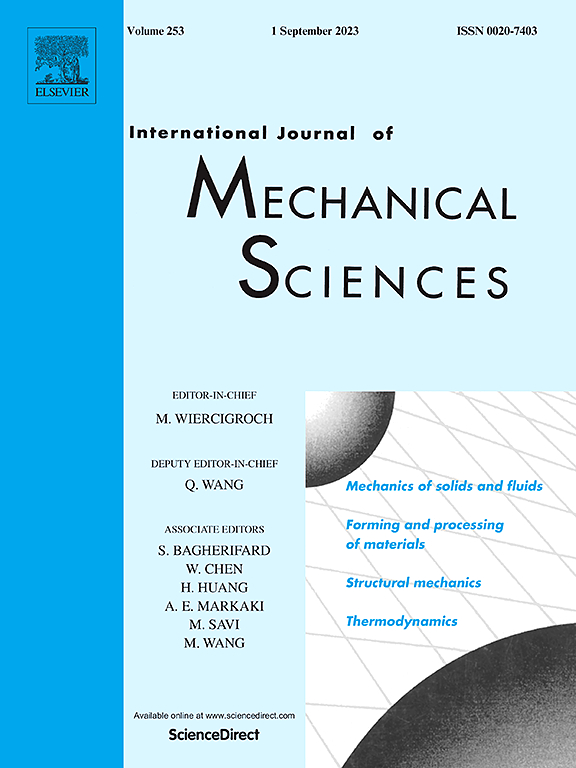A chemo-thermo-viscoelastic model for early-age concrete behaviors
IF 7.1
1区 工程技术
Q1 ENGINEERING, MECHANICAL
International Journal of Mechanical Sciences
Pub Date : 2025-04-28
DOI:10.1016/j.ijmecsci.2025.110304
引用次数: 0
Abstract
In this study, a novel chemo-thermo-viscoelastic phase field model is proposed for simulating early-age concrete behaviors. The model integrates multiple chemical and physical processes, including hydration reaction, thermal conduction, elastic and viscous deformations, damage, and their interactions. The thermodynamic consistency of these coupled processes is ensured through the first and second laws of thermodynamics. In the model, elastic and viscous processes are described incrementally using the solidification theory, accounting for property evolution during hydration. Damage, coupled with elastic and viscous deformations is modeled with a new viscoelastic phase field framework employing Kelvin-Voigt chains. Additionally, chemo-thermal effects are coupled with deformations through autogenous shrinkage, thermal expansion, and thermal transient creep. The model’s validation is verified through three representative experiments: a creep test, a thermally active restrained shrinkage ring test, and a massive concrete wall cracking test. The simulation results show good alignment with the experimental data.

早期混凝土行为的化学-热-粘弹性模型
在这项研究中,提出了一种新的化学-热-粘弹性相场模型来模拟早期混凝土的行为。该模型集成了多种化学和物理过程,包括水化反应、热传导、弹性和粘性变形、损伤及其相互作用。这些耦合过程的热力学一致性是通过热力学第一和第二定律来保证的。在模型中,利用凝固理论对弹性和粘性过程进行增量描述,以考虑水化过程中的性能演变。采用一种新的Kelvin-Voigt链粘弹性相场框架对弹性和粘性变形耦合的损伤进行了建模。此外,化学热效应与自收缩、热膨胀和热瞬态蠕变等变形相结合。通过蠕变试验、热活性约束收缩环试验和大体积混凝土墙体开裂试验,验证了模型的有效性。仿真结果与实验数据吻合较好。
本文章由计算机程序翻译,如有差异,请以英文原文为准。
求助全文
约1分钟内获得全文
求助全文
来源期刊

International Journal of Mechanical Sciences
工程技术-工程:机械
CiteScore
12.80
自引率
17.80%
发文量
769
审稿时长
19 days
期刊介绍:
The International Journal of Mechanical Sciences (IJMS) serves as a global platform for the publication and dissemination of original research that contributes to a deeper scientific understanding of the fundamental disciplines within mechanical, civil, and material engineering.
The primary focus of IJMS is to showcase innovative and ground-breaking work that utilizes analytical and computational modeling techniques, such as Finite Element Method (FEM), Boundary Element Method (BEM), and mesh-free methods, among others. These modeling methods are applied to diverse fields including rigid-body mechanics (e.g., dynamics, vibration, stability), structural mechanics, metal forming, advanced materials (e.g., metals, composites, cellular, smart) behavior and applications, impact mechanics, strain localization, and other nonlinear effects (e.g., large deflections, plasticity, fracture).
Additionally, IJMS covers the realms of fluid mechanics (both external and internal flows), tribology, thermodynamics, and materials processing. These subjects collectively form the core of the journal's content.
In summary, IJMS provides a prestigious platform for researchers to present their original contributions, shedding light on analytical and computational modeling methods in various areas of mechanical engineering, as well as exploring the behavior and application of advanced materials, fluid mechanics, thermodynamics, and materials processing.
 求助内容:
求助内容: 应助结果提醒方式:
应助结果提醒方式:


